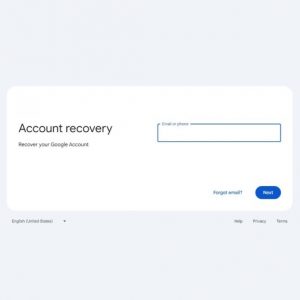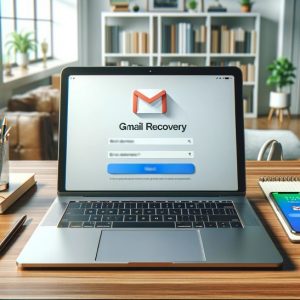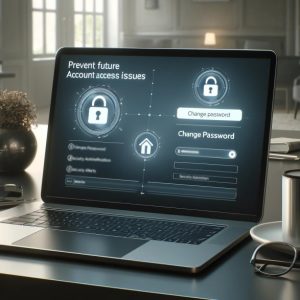Gmail Account Recovery
In today’s digital world, an email account serves not just as a means of communication but as a gateway to numerous online services and essential interactions. A Gmail account is particularly pivotal due to its integration with a plethora of services, from social media and online shopping to business tools and personal data storage. Losing access to a Gmail account can disrupt daily activities and pose significant data security risks.
Several reasons might necessitate the need to recover a Gmail account. Commonly, individuals find themselves locked out due to forgotten passwords—a simple yet troubling predicament. In other instances, the security of a Gmail account might be compromised, making the Gmail recovery process urgent to prevent data theft or misuse.
Moreover, situations such as the need to retrieve old Gmail account data or to recover deactivated Gmail account settings also prompt users to seek recovery solutions. Whether it’s retrieving valuable historical correspondence or restoring access to linked services, the ability to recover access is crucial.
The questions of how to recover Gmail account is frequently asked by users who find themselves in such predicaments. Each scenario, whether it involves forgotten credentials or unauthorized access, requires swift and effective strategies to reclaim control of one’s digital life.
In the following sections, we will delve into the step-by-step processes and best practices to securely recover your Gmail account, ensuring you can regain access with minimal hassle and resume your online activities seamlessly.
Pre-Recovery Checklist to Recover a Gmail Account
Before attempting to recover a Gmail account, it is vital to prepare and verify certain details that will facilitate a smooth recovery process. This pre-recovery checklist ensures that you are equipped with all necessary information and that your devices are secured to prevent further complications.
Verify Your Gmail Account Details
When preparing to recover a Gmail account, the first step is to ensure that you have access to or remember key details associated with your account. Knowing your full email address is ideal, but even recalling part of it can be helpful. Additionally, having other recovery options ready, such as a secondary recovery email or a linked phone number, can significantly expedite the recovery process.
Information that proves particularly beneficial includes:
- The full or partial email address of the Gmail account you wish to recover.
- Any recovery email addresses that may have been specified when setting up the account.
- Phone numbers linked to the account for SMS verification.
- The approximate date you last accessed your account, which can help verify your identity to Google.
Ensuring you have these details can answer the question of “how do you recover a Gmail account” more efficiently, as Google uses this information to confirm your identity and speed up the recovery process.
Secure Your Connected Devices
Securing devices you use to access your Gmail account is an essential step in the Gmail account recovery process. This is crucial not only to prevent unauthorized access during the recovery phase but also to maintain account security after regaining access.
Steps to secure your devices include:
- Updating all software to the latest versions to patch any security vulnerabilities.
- Running antivirus software to detect and remove malware or spyware that might compromise your account recovery efforts.
- Ensuring that any device used to log in to your Gmail account has a secure lock screen and strong authentication methods.
By securing your devices, you help safeguard against further complications that might arise, such as someone gaining unauthorized access to your recovered account. This is particularly important if you initially lost access due to security issues, such as hacking. If you suspect that your account has been hacked, you can read our blog on Gmail account hacked.
Remember, the ability to recover old Gmail account data or regain control over a currently inaccessible account hinges significantly on how well-prepared and secured your initial recovery environment is. This not only applies to those who can’t recover Gmail account credentials immediately but also to those seeking old Gmail account recovery after a long period of inactivity.
Steps to Recover a Gmail Account
Successfully navigating the process to recover a Gmail account requires understanding and using Google’s tools effectively. This section offers a comprehensive guide on using the Gmail account recovery page and handling various recovery scenarios.
Using the Gmail Account Recovery Page
To begin the recovery of your Gmail account, visit the official Gmail account recovery page at Google Account Recovery. Here’s a step-by-step guide on what to do:
-
Enter Email or Phone Number:
Start by entering email address or phone number associated with account. Click ‘Next’.
-
Verify your Identity:
Google will ask for the last password you remember. If you don’t remember any, select ‘Try another way’ to move to different verification methods.
-
Follow On-screen Instructions:
Continue following the prompts. Google might send a verification code to a recovery email or phone number.
During this process, be prepared for possible delays or verification steps, depending on your specific account details and security settings. Google uses this process to ensure that it’s truly you trying to recover your account.
Answer Security Questions
If prompted with security questions during the Gmail recovery process, here are some tips:
-
Be as Accurate as Possible:
Try to remember exact answers. Even small deviations can cause issues.
-
Think About Different Time Periods:
Your answer might relate to a time when you first created the account.
-
Don’t Rush:
Take your time to think about your answers. Incorrect attempts might delay or halt the recovery process.
Security questions are a critical part of the identity verification process and require careful attention to detail.
Utilize Recovery Email or Phone Number for Gmail Recovery
Using your recovery email or phone number effectively can greatly streamline the Gmail account recovery process:
-
Check Your Recovery Options:
Before starting, ensure recovery email and phone number are up to date.
-
Access to Recovery Tools:
Ensure you have access to the recovery email account or phone. If you receive a code, enter it promptly on the recovery page.
-
Prompt Action:
Act quickly when you receive recovery prompts, as codes and links may expire.
These recovery options are vital for proving your identity and regaining access to your account.
Dealing with Two-Factor Authentication Issues
If you encounter issues with Two-Factor Authentication (2FA) such as not having access to your 2FA device, here are steps to follow:
-
Use Backup Codes:
If you have previously set up and saved backup codes, use one to gain access.
-
Request Help from Google:
If backup options aren’t available, follow the prompts on the account recovery page to explain your situation to Google and seek alternative verification methods.
-
Verify Identity:
You may be asked additional questions about your account to verify your identity.
Handling 2FA issues carefully is crucial as this adds an extra layer of security and complication to the Gmail recovery process.
By following these detailed steps, users can effectively navigate the complexities of Gmail account recovery, from using the recovery page to addressing 2FA challenges, ensuring that they can retrieve old Gmail account information securely and efficiently.
What to Do if Gmail Account Recovery Options Fail
Despite following the outlined steps for Gmail account recovery, there may be situations where you still can’t regain access to your account. This section addresses what to do if standard recovery options fail.
Submitting an Account Recovery Request
When simpler recovery methods do not work, submitting a detailed account recovery form can be the next step. This form is specifically designed for users who have exhausted other avenues:
-
Access the Form:
Navigate to the Gmail account recovery form on Google’s support site. You can find this by searching for “Gmail account recovery form” or through the help pages related to account issues.
-
Provide Detailed Information:
Fill out the form with as much detail as possible. This includes your email address, the last password you remember, any recovery codes you might have, and details about the last successful access to your account.
-
Explain Your Situation:
Clearly explain why you are not able to recover your account through the usual means. For example, if you have lost access to your recovery email or phone, detail these circumstances.
-
Submit the Form:
After reviewing your information, submit the form. It can take several days for Google to respond, so patience is key.
Using the Gmail account recovery form is crucial for those who can’t recover their Gmail account through standard methods. It’s particularly useful for complex issues like not having access to any previously configured recovery options.
By understanding how to contact Google support and how to utilize the Gmail recovery form, users can enhance their chances of recovering their account even when initial recovery efforts fail. Whether it’s to recover a deactivated Gmail account or to retrieve an old Gmail account, these steps provide a critical recourse for users facing access issues.
Preventing Future Gmail Account Access Issues
After successfully navigating the hurdles of Gmail account recovery, it’s crucial to take proactive steps to prevent similar issues in the future. This section focuses on maintaining security through updating recovery options, employing strong password practices, and utilizing two-factor authentication.
Update Recovery Options Regularly
One of the most effective ways to ensure you can always recover a Gmail account is to keep your recovery options up-to-date. Here’s why and how to maintain your recovery details:
-
Periodic Updates:
As life circumstances change, so can contact information. Regularly updating your recovery email and phone number ensures you’re always prepared.
-
Access to Recovery Tools:
Always have access to the email or phone number listed as your recovery option. This is crucial if you need to recover a deactivated Gmail account or retrieve an old Gmail account.
-
How to Update:
Navigate to your Google Account settings, find the ‘Security’ section, and update your recovery email or phone. This is also where you can manage your security questions and other account recovery options.
Strong Password Practices
Effective password management is foundational to securing your online accounts. Here are some tips for creating and managing strong passwords:
-
Complexity and Length:
Ensure your passwords are long (at least 12 characters) and include combination of letters, numbers, and symbols.
-
Avoid Common Pitfalls:
Do not use easily guessed passwords such as “123456” or “password.” Also, avoid using personal information like Date of Birth or names.
-
Use a Password Manager:
Consider using password manager to keep track of your passwords. This tool can also generate strong passwords for you.
-
Regular Changes:
While changing passwords too frequently can be counterproductive, it’s wise to update them periodically, especially after a security breach.
If you’ve lost or forgotten your password, you can read our detailed blog on Gmail account password recovery.
The Benefits of Two-Factor Authentication
Two-factor authentication (2FA) adds a extra layer of security beyond your password, significantly enhancing your account’s safety:
-
How 2FA Works:
When 2FA is enabled, accessing your account requires both password and a second factor, often sent a code to your phone or generated by an app.
-
Enhanced Security:
Even if someone gets hold of your password, they won’t be able to access your account without also having access to your second factor.
-
Setting Up 2FA:
You can enable 2FA from your Google Account security settings. Choose between text message codes, authentication apps, or backup codes as your preferred method.
By adhering to these guidelines—regularly updating recovery options, practicing strong password hygiene, and enabling two-factor authentication—you can safeguard your Gmail account against future access issues and minimize the need for recovery. These measures are essential for maintaining security and integrity of your digital identity.
FAQs
Q1. How do I recover a Gmail account if I’ve forgotten the password?
- A. To recover a Gmail account, visit the Gmail account recovery page and enter email address. Follow on-screen steps to reset your password using a recovery email, phone number, or by answering your security questions.
Q2. What should I do if I can’t recover my Gmail account through the recovery page?
- A. If you can’t recover your Gmail account using the standard methods, you can fill out the Gmail account recovery form for more in-depth assistance. Make sure to provide as much information as possible to prove your ownership of the account.
Q3. How can you recover a Gmail account if the account recovery options are outdated?
- A. If your recovery options are outdated, you may still attempt to recover your Gmail account by providing other details that Google asks for, such as previous passwords or account creation dates. If these attempts fail, use the Gmail account recovery form to submit a detailed recovery request.
Q4. What steps should I take to recover a deactivated Gmail account?
- A. To recover a deactivated Gmail account, start by using the standard Gmail account recovery tools. If your account has been deactivated due to inactivity, Google will provide specific instructions on how to reactivate it during the recovery process.
Q5. How do you recover a Gmail account if you no longer have access to the phone number associated with it?
- A. If you’ve lost access to the phone number linked to your Gmail, start the recovery process on the Gmail account recovery page and select ‘Try another way’ when prompted to enter a code from your phone. You may be asked to confirm information related to other recovery options or account activities.
Q6. Can I retrieve an old Gmail account I haven’t used in several years?
- A. Yes, you can retrieve an old Gmail account using the Gmail account recovery page. You’ll need to provide as much information as possible to identify and verify the account ownership.
Q7. What are the best practices for ensuring I can always recover my Gmail account?
- A. To ensure you can always recover your Gmail account, keep your recovery options (email and phone number) up-to-date, use strong, unique passwords, and enable two-factor authentication for added security.
Q8. How to contact Gmail support directly for help recovering a Gmail account?
- A. To contact Gmail to recover an account, visit Google’s official support page and navigate to the contact or help section where you can submit a request for direct support or access live chat options, depending on the nature of your account issue.
Q9. What are the common reasons Gmail can’t recover an account?
- A. Common reasons Gmail can’t recover an account include having insufficient proof of ownership, outdated or inaccessible recovery options, or repeated failed attempts that lock the recovery process temporarily.
Q10. How do you recover a Gmail account that was deleted recently?
- A. To recover Gmail account that was deleted, you need to act quickly as Google allows a short window to recover recently deleted accounts. Start the recovery process on the Gmail account recovery page and follow the prompts to restore your account.
Conclusion
Throughout this guide, we have explored various methodologies and techniques to recover a Gmail account, emphasizing the importance of utilizing the Gmail account recovery page, accurately responding to security questions, and effectively leveraging recovery options like email and phone numbers. Furthermore, we discussed essential measures for cases where standard recovery efforts fall short, including detailed steps on contacting Google support and submitting an account recovery request.
Recovering access to your account is crucial, but it’s only part of the journey towards securing your digital life. To safeguard against future issues and ensure ongoing security, it’s vital to keep your recovery options up to date. This not only simplifies any necessary recovery processes but also strengthens your account’s defenses against unauthorized access.
In addition to regular updates, implementing robust password practices is paramount. Creating complex passwords and possibly using a password manager can significantly enhance your account’s security. Moreover, enabling Two-Factor Authentication (2FA) provides an additional layer of protection, making it much difficult for unauthorized users to access even if they discover your password.
The digital environment is continuously evolving, with new threats emerging regularly. Thus, maintaining the security of your online accounts requires vigilance and proactive management. By staying informed about how to recover your Gmail account and applying these preventive measures, you can not only recover but also fortify your accounts against future challenges.
Keep in mind that the security of your online presence is of utmost importance. Regular maintenance and stringent security measures are essential in protecting your Gmail account and, by extension, your digital identity. Whether you are looking to recover a deactivated Gmail account or simply retrieve an old Gmail account, these practices will empower you to maintain control over your online interactions and ensure your peace of mind. To know more about Gmail account recovery and resolve its related issues, please visit Gmail Support page.

Elizabeth wilson
I have lost access to both the recovery email and phone number previously set up in my Gmail account settings. How can I successfully recover my Gmail account under these circumstances?
Support Admin
To recover your Gmail account when you no longer have access to your registered recovery email or phone number, begin by visiting the Gmail account recovery page. Input the full email address of the account you’re trying to access and select ‘Next’. When prompted for the recovery email or phone number, choose ‘Try another way’ to explore other verification methods. Google may ask for any passwords you remember or for answers to security questions. Provide as much accurate information as you can. If you’re still unable to recover using these methods, you should fill out the Gmail account recovery form, detailing your specific situation to help Google verify your identity and consider restoring access to your account.